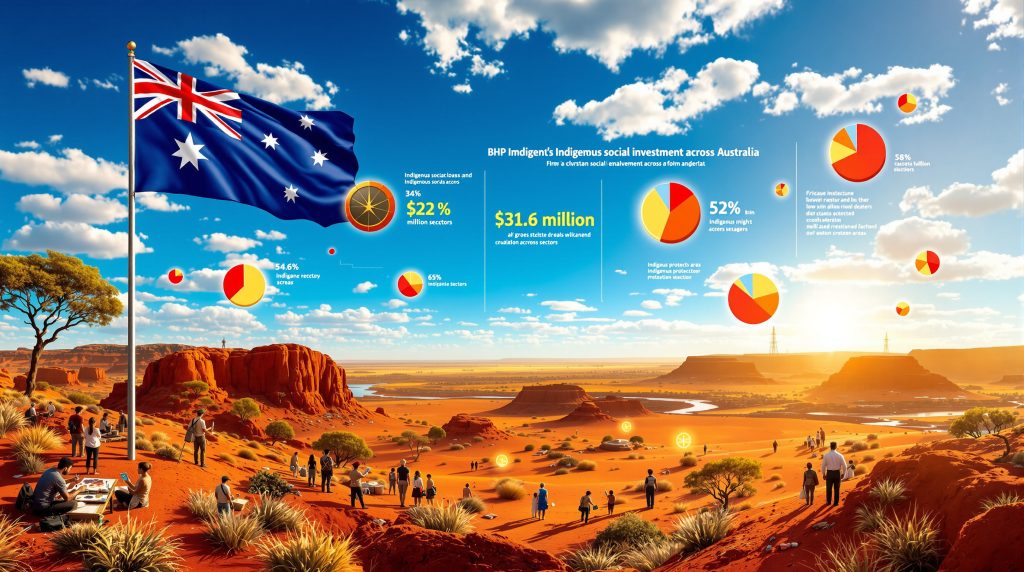Understanding BHP's Community-Focused Investment Philosophy
BHP Indigenous social investment represents a fundamental shift from traditional corporate philanthropy toward genuine partnership-based community development. The mining company's approach centers on empowering Aboriginal and Torres Strait Islander communities to design and implement their own development initiatives while receiving sustained operational and financial support. This transformation reflects broader industry evolution trends occurring across the mining sector.
The company's investment philosophy recognises Indigenous peoples as critical partners and stakeholders rather than passive beneficiaries. This positioning reflects organisational understanding that sustainable community transformation requires community ownership of development processes, not externally imposed solutions.
Strategic Partnership Framework
BHP's methodology involves extensive consultation periods where Indigenous communities identify priority areas before investment decisions occur. This community-led approach ensures resource allocation aligns with genuine aspirations rather than corporate assumptions about community needs.
The framework operates through multi-year funding commitments spanning five or more years, enabling substantive capacity building rather than short-term project delivery. This timeline recognition acknowledges that meaningful community development requires sustained institutional relationships, not discrete funding cycles.
Cultural preservation integrates seamlessly with economic development initiatives, preventing economic advancement from eroding Indigenous cultural practices. Instead, both elements function as complementary processes strengthening community resilience and self-determination.
Comprehensive Analysis of BHP's $31.8 Million Investment Distribution
The 2025 financial year demonstrated BHP's systematic approach to Indigenous community investment, with strategic allocation across six core development sectors designed to maximise long-term community impact. Furthermore, this approach aligns with contemporary data-driven mining operations that prioritise evidence-based decision-making.
| Investment Sector | FY25 Allocation | Percentage | Focus Areas |
|---|---|---|---|
| Community Health & Wellbeing | $9.4 million | 29.6% | Healthcare infrastructure, mental health programming, community facilities |
| Indigenous Governance & Economic Development | $8.4 million | 26.4% | Business development, leadership capacity, institutional strengthening |
| Education & Training | $5.0 million | 15.7% | Skills development, tertiary pathways, vocational training |
| Knowledge, Languages & Technologies | $4.3 million | 13.5% | Cultural documentation, digital literacy, traditional knowledge integration |
| Arts & Culture | $2.8 million | 8.8% | Creative industries, cultural expression, artistic enterprises |
| Country, Nature & Environment | $1.6 million | 5.0% | Land management, conservation, environmental restoration |
Source: BHP Australian Indigenous Social Investment Report, FY25
Additional Community Support Mechanisms
Beyond the core $31.8 million allocation, BHP channelled an additional $22.4 million through complementary social value initiatives, bringing total Indigenous community investment to over $54 million for the fiscal year. This broader investment approach indicates systematic integration of Indigenous community considerations across multiple organisational functions.
The health and wellbeing allocation representing nearly 30% of total investment signals organisational recognition that sustainable community development requires robust healthcare foundations encompassing both physical infrastructure and mental health support systems.
Economic development and governance structures receiving the second-largest allocation demonstrates BHP's emphasis on building institutional capacity within communities rather than creating externally dependent service delivery models.
Indigenous Leadership Development Programs and Investment Priorities
Leadership capacity development represents a cornerstone of BHP Indigenous social investment strategy, with the company allocating substantial resources toward building strong local leadership foundations for sustainable community transformation. However, addressing women's leadership challenges remains a critical focus area across the sector.
West Australian Aboriginal Leadership Institute Partnership
- Investment Value: $1.875 million over five years (FY25-FY29)
- Annual Average: $375,000 per annum
- Geographic Focus: Western Australia communities
- Key Initiative: Yorga Djenna Bidi (Aboriginal Women's Leadership Program)
Program Effectiveness and Outcomes
The Yorga Djenna Bidi program has successfully graduated over 250 participants who combine traditional Aboriginal wisdom with contemporary leadership methodologies. This hybrid approach addresses a critical gap in leadership education by integrating culturally rooted decision-making systems with modern organisational management competencies.
Program success has prompted expansion into men's leadership development and elder engagement processes, indicating demonstrated effectiveness sufficient to justify scaling across broader community segments. The five-year commitment reflects organisational understanding that leadership capacity requires sustained institutional relationships rather than discrete project funding.
The 250+ graduate cohort represents substantial capacity development within Western Australian Aboriginal communities, creating networks of skilled leaders equipped to guide community development initiatives independently.
Economic Development Strategy and Business Leadership Initiatives
BHP's economic development approach acknowledges that Indigenous businesses contribute significantly to Australia's economic landscape while requiring specialised support to overcome systemic barriers to business development and growth.
Melbourne Business School Partnership – Dilin Duwa Centre
- Investment Amount: $20 million over two years
- Direct Participants: Over 150 Indigenous participants in structured programs
- Extended Reach: 350+ people across Australia through regional series
- Service Model: Comprehensive business education platform
Business Development Framework Components
The Dilin Duwa Centre operates through multiple service delivery mechanisms designed to address the full spectrum of business development needs:
- Structured Business Education: Curriculum-based programs covering fundamental business principles
- Mentorship Platforms: Experiential learning through connection with established business leaders
- Networking Opportunities: Relationship capital development for ongoing business support
- Capital Access Guidance: Financial literacy and funding pathway navigation
- Regional Business Series: Geographic accessibility for remote communities
- Online Learning Platforms: Technology-enabled access for digitally connected communities
The $20 million allocation representing approximately 63% of the total education and training budget demonstrates BHP's prioritisation of economic development pathways as primary vehicles for sustainable community transformation.
Geographic and Digital Accessibility
The 350+ participant reach through regional delivery series demonstrates intentional program design addressing geographic dispersal challenges facing many Indigenous communities located in remote areas with limited access to business education infrastructure.
Online learning platform integration addresses digital divide barriers, providing technology-enabled pathways for communities without proximity to urban business education centres while building digital literacy capacity simultaneously.
Environmental Conservation and Cultural Land Management Integration
BHP's environmental investment strategy integrates traditional Indigenous land management practices with contemporary conservation science, creating dual benefits for ecological health and cultural continuity through place-based stewardship models. This approach complements broader mine reclamation innovation initiatives across the industry.
Queensland Indigenous Land and Conservation Project (QILCP) Achievements
- Land Restoration: 375 hectares rehabilitated annually
- Water Quality Protection: 11 tonnes of sediment prevented from reaching Great Barrier Reef
- Employment Creation: 63 First Nations people employed in conservation roles
- Skills Development: 53 individuals trained in environmental restoration specialisations
- Training-to-Employment Success: 84% of trained individuals secured employment
Indigenous Protected Areas Network Impact
Through the Indigenous Desert Alliance, BHP supports a comprehensive conservation network that demonstrates the disproportionate conservation contribution of Indigenous-managed lands:
- Protected Areas Supported: 27 Indigenous Protected Areas across multiple bioregions
- Conference Participation: 430 participants in bi-annual knowledge-sharing events
- Active Ranger Network: 300 First Nations rangers employed full-time
- National Conservation Contribution: 40% of Australia's National Reserve System
The 40% contribution to Australia's National Reserve System by Indigenous-managed lands, despite Indigenous peoples representing approximately 3% of Australia's population, underscores the efficiency and effectiveness of traditional land stewardship models integrated with contemporary conservation techniques.
Environmental and Economic Integration
The QILCP model demonstrates practical integration of habitat restoration, water quality management, employment creation, and vocational skills development within a single program framework. The 375 hectares annual restoration rate equals approximately 937 acres of landscape-scale transformation, providing measurable ecosystem service value.
The 11 tonnes of sediment prevented from reaching the Great Barrier Reef represents quantifiable environmental impact addressing documented threats to coral health and marine ecosystem productivity.
Cultural Arts and Heritage Preservation Through Economic Viability
BHP's arts and culture investment recognises that cultural preservation occurs most effectively through active cultural practice supported by economic viability rather than archival documentation alone.
Aboriginal Art Centre Hub (Western Australia) Network
- Artist Representation: 5,000 artists across the network
- Art Centre Infrastructure: 24 art centres providing local support
- Community Engagement: 40 Indigenous communities directly involved
- Investment Allocation: $2.8 million (8.8% of total Indigenous investment)
Cultural Practice and Economic Sustainability
The multi-community network model spanning 40 communities across 24 centres acknowledges that Indigenous artistic traditions remain geographically distributed and culturally localised, requiring place-based support infrastructure rather than centralised delivery models.
By supporting 5,000 artists through the hub network, BHP creates economic incentive structures enabling artists to sustain livelihoods through cultural work, preventing economic pressure from forcing artists away from traditional practices.
Indigenous Cultural Respect Framework Implementation
BHP's workforce development through the Indigenous Cultural Respect Framework (ICRF) provides structured cultural capability development across the organisation:
- Formal Learning Modules: Structured curriculum on Indigenous cultural protocols and contemporary realities
- Informal Learning Resources: Documentary materials and storytelling sessions
- Cultural Immersion Experiences: Direct engagement with Indigenous knowledge holders
- Competency Assessment: Ongoing evaluation of employee cultural capability development
- Mentorship Programs: Knowledge transfer from Indigenous cultural experts
Educational Pathway Development and Skills Training Outcomes
Education and training investments focus on creating accessible pathways for Indigenous people to participate in higher education, vocational training, and specialised skill development opportunities while maintaining cultural connections and community ties.
Follow the Dream Program Implementation
Partnership with the Polly Farmer Foundation has delivered significant educational support outcomes:
- Tuition Delivery: Over 13,000 hours of specialised academic support
- Program Components: Academic tutoring, mentorship, and career guidance
- Long-term Impact: Increased tertiary education participation rates among participants
- Cultural Integration: Programs designed to maintain cultural identity while advancing educational achievement
Women's Professional Development Through Ember Connect
The Ember Connect initiative specifically addresses Indigenous women's professional advancement through targeted support mechanisms:
- Participant Engagement: 4,100+ women participated in professional development activities
- Specialised Support: Dedicated team focusing on Indigenous women's career advancement
- Skills Training: Technical and leadership capability development
- Network Building: Professional connections and ongoing mentorship opportunities
The substantial participation rate demonstrates significant demand for women-focused professional development programming within Indigenous communities, indicating this represents a previously underserved development area.
Investment Success Measurement and Community Feedback Integration
BHP employs comprehensive measurement frameworks combining quantitative performance indicators with qualitative community feedback to assess investment effectiveness and guide strategic program development decisions.
Key Performance Assessment Areas
Quantitative Measurement Indicators:
- Community participation rates and program retention statistics
- Skills development completion rates and employment outcome tracking
- Leadership capacity growth within partner communities
- Economic development indicators including business formation and employment generation
- Environmental restoration outcomes and conservation impact metrics
Qualitative Assessment Methods:
- Regular community consultation sessions with program participants
- Cultural impact assessments measuring language maintenance and cultural practice strengthening
- Partnership satisfaction evaluations from Indigenous organisation partners
- Long-term community development outcome assessments
- Participant outcome tracking across multiple program areas
Continuous Improvement Through Community Input
The measurement approach emphasises community ownership of evaluation processes, ensuring assessment criteria reflect community priorities rather than external performance frameworks. This approach enables program adaptation based on community feedback while maintaining accountability for investment outcomes.
Regular consultation sessions provide ongoing opportunities for program refinement, ensuring initiatives remain aligned with evolving community needs and priorities across different geographic and cultural contexts.
Future Strategic Developments and Program Expansion Plans
Looking toward FY26, BHP has outlined strategic initiatives designed to enhance program effectiveness, expand community impact, and improve organisational systems supporting Indigenous partnership relationships. These developments align with insights from recent innovation expo insights showcasing sector-wide advancement opportunities.
Planned Strategic Initiatives
Indigenous Social Investment Community of Practice Development:
- Knowledge-sharing network establishment between partner organisations
- Best practice documentation and distribution across programs
- Peer learning opportunities for community organisations
- Cross-program collaboration facilitation
Organisational Process Improvements:
- Streamlined partnership approval processes for faster program implementation
- Enhanced internal coordination between BHP divisions supporting Indigenous initiatives
- Improved communication systems between corporate teams and community partners
- Expanded geographic reach extending successful programs to additional communities
Technology Integration and Innovation Development
Future program development will incorporate emerging technologies to enhance accessibility and effectiveness:
- Digital Platform Development: Remote community engagement through online program delivery
- Cultural Preservation Technology: Advanced documentation methods for traditional knowledge systems
- Data Analytics Integration: Improved program targeting through community needs analysis
- Virtual Reality Applications: Immersive cultural education experiences for workforce development
These technological enhancements aim to address geographic barriers while maintaining the personal relationship focus essential to effective Indigenous community partnership.
Industry Leadership and Comparative Investment Analysis
BHP's systematic approach to BHP Indigenous social investment positions the company as a leader within the mining sector's community engagement practices, with its $31.8 million annual commitment representing substantial industry investment scale.
Best Practice Framework Elements
Industry-Leading Approaches:
- Long-term Partnership Commitments: Five-year plus funding agreements enabling substantial program development
- Community-Led Program Design: Bottom-up methodology ensuring community ownership of development processes
- Comprehensive Measurement Systems: Integrated quantitative and qualitative assessment frameworks
- Cultural Competency Integration: Systematic workforce development in Indigenous cultural understanding
Scalable Model Components:
- Multi-sector investment approach addressing health, education, economic development, and cultural preservation simultaneously
- Geographic distribution strategies addressing remote community accessibility challenges
- Technology integration maintaining personal relationship emphasis
- Partnership governance models ensuring community decision-making authority
Mining Sector Investment Context
While specific comparative data across mining companies remains limited in publicly available documentation, BHP's investment scale and systematic methodology indicate substantial commitment to Indigenous community development relative to typical corporate social responsibility programs. The BHP Foundation's broader initiatives further demonstrate this comprehensive approach to community engagement.
The integration of cultural preservation with economic development, rather than treating these as competing priorities, demonstrates sophisticated understanding of Indigenous community development dynamics that could serve as an industry model.
Disclaimer: Investment outcomes and program effectiveness may vary based on community-specific factors, economic conditions, and external circumstances beyond program control. Future program developments remain subject to organisational strategic planning processes and community partnership negotiations.
Looking to Invest in Mining Companies Making Genuine Community Impact?
Discovery Alert's proprietary Discovery IQ model delivers real-time alerts on significant ASX mineral discoveries, helping investors identify companies with sustainable community partnerships like BHP's Indigenous investment initiatives. Explore Discovery Alert's historic discovery examples and begin your 30-day free trial to position yourself ahead of the market with actionable insights into responsible mining investments.




